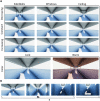Measuring arousal and valence generated by the dynamic experience of architectural forms in virtual environments
- PMID: 35927322
- PMCID: PMC9352685
- DOI: 10.1038/s41598-022-17689-9
Measuring arousal and valence generated by the dynamic experience of architectural forms in virtual environments
Abstract
The built environment represents the stage surrounding our everyday life activities. To investigate how architectural design impacts individuals' affective states, we measured subjective judgments of perceived valence (pleasant and unpleasant) and arousal after the dynamic experience of a progressive change of macro visuospatial dimensions of virtual spaces. To this aim, we developed a parametric model that allowed us to create 54 virtual architectural designs characterized by a progressive change of sidewalls distance, ceiling and windows height, and color of the environment. Decreasing sidewalls distance, ceiling height variation, and increasing windows height significantly affected the participants' emotional state within virtual environments. Indeed, such architectural designs generated high arousing and unpleasant states according to subjective judgment. Overall, we observed that valence and arousal scores are affected by all the dynamic form factors which modulated the spaciousness of the surrounding. Showing that the dynamic experience of virtual environments enables the possibility of measuring the emotional impact of macro spatial architectural features, the present findings may lay the groundwork for future experiments investigating the effects that the architectural design has on individuals' mental state as a fundamental factor for the creation of future spaces.
© 2022. The Author(s).
Conflict of interest statement
Author G.V. has received research support from Lombardini22. Other authors do not have competing interest.
Figures






References
-
- Bower I, Tucker R, Enticott PG. Impact of built environment design on emotion measured via neurophysiological correlates and subjective indicators: A systematic review. J. Environ. Psychol. 2019;66:101344. doi: 10.1016/j.jenvp.2019.101344. - DOI
-
- Vartanian O, et al. Architectural design and the brain: Effects of ceiling height and perceived enclosure on beauty judgments and approach-avoidance decisions. J. Environ. Psychol. 2015;41:10–18. doi: 10.1016/j.jenvp.2014.11.006. - DOI
Publication types
MeSH terms
LinkOut - more resources
Full Text Sources

